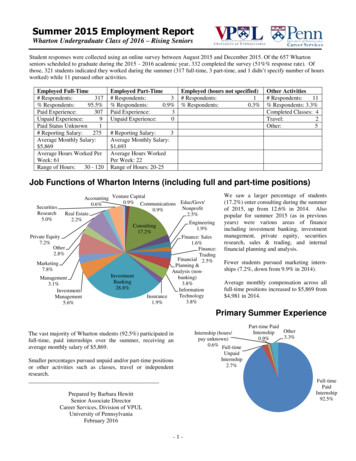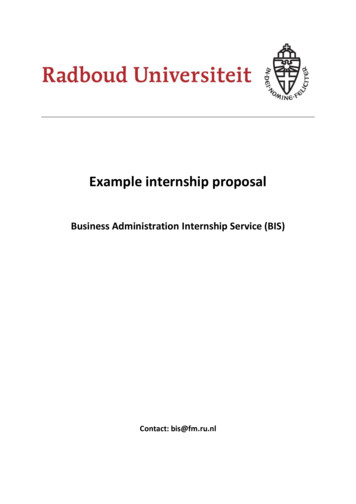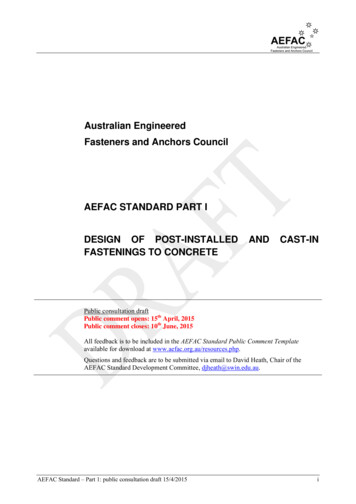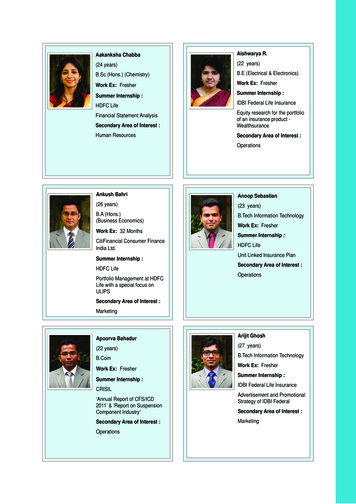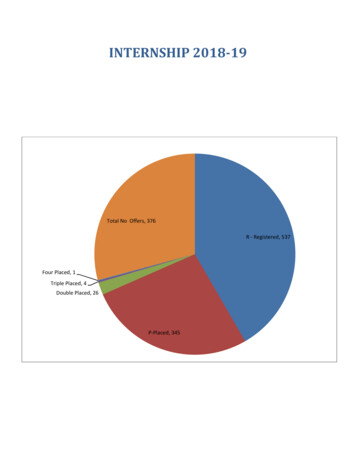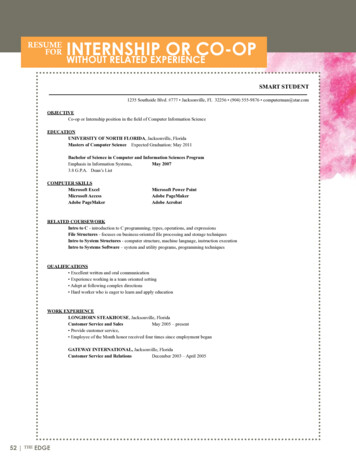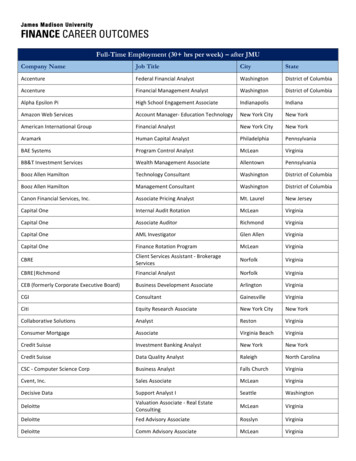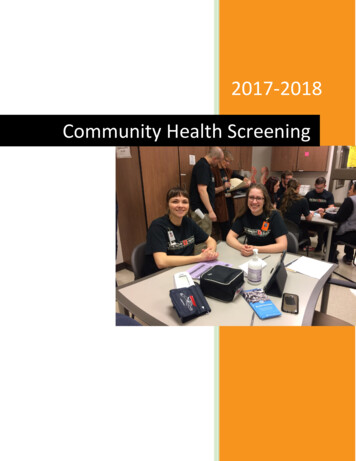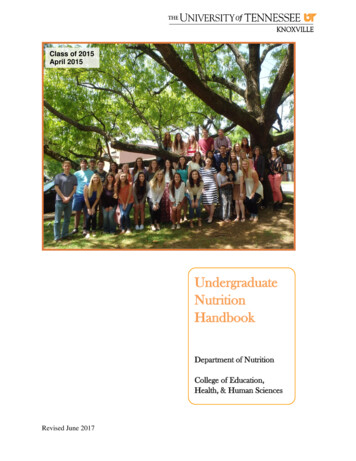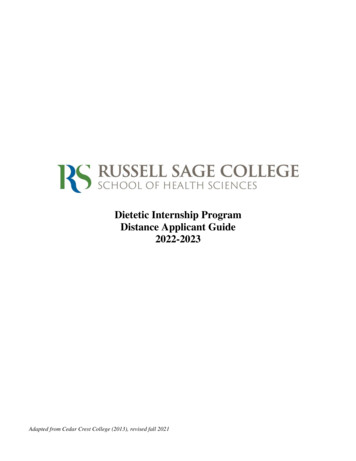
Transcription
Dietetic Internship ProgramDistance Applicant Guide2022-2023Adapted from Cedar Crest College (2013), revised fall 2021
Welcome prospective distance interns!Thank you for your interest in completing your Dietetic Internship at Russell Sage College. This applicantguide provides important information to assist you in setting up your supervised practice experiences aspart of the program. It is imperative that you begin connecting with potential preceptors to secure yoursupervised practice sites as soon as possible. All sites must be secured upon application to the distancetrack to be considered. Should you have any questions please do not hesitate to contact us.Sincerely,Professor MorganProgram Contact Information:Michelle Morgan, MS, RDN, CDNDirector, Dietetic Internshipmorgam1@sage.eduMichelle Guy, MS, RDNCoordinator, Dietetic Internshipwalkem4@sage.edu2022-2023 Tentative Program CalendarMandatory Pre-orientation (virtual): May and JuneMandatory Orientation in Troy, NY: August 23-25Practicum I: August 29-November 15Practicum II: December 5-February 24Practicum III: March 20-June 5Exit week: June 12-16Note, advising, presentation, class and makeup days are held between practicums.Supervised Practice Hour RequirementsROTATIONClinicalAcute CareNUMBER OF HOURS600 hours440 hours (11 weeks)Outpatient80 hours (2 weeks)Long Term CareFood Service ManagementCommunityTotal Hours80 hours (2 weeks)400 hours (10 weeks)280 hours (7 weeks)1280General Rotation Guidelinesa. You must meet the minimum hours in each practicum category and the total number of requiredhours in order to meet the Russell Sage College distance program requirements.Adapted from Cedar Crest College (2013), revised fall 2021
b. Rotations can be split between different facilities. For example, two weeks at a WIC and fiveweeks at the department of health; Outpatient rotation: 1 week in renal and 1 week in endocrine orbariatrics. Note: If your facility has an outpatient clinic, this may be used for your outpatientrotation.c. You may plan for the majority of your acute care clinical experience to take place in a high acuityrehab facility, however at least 4 weeks of acute care must take place in a hospital setting.d. Be imaginative when you choose your placements. You may contact the program director todiscuss placement options to ensure they are acceptable.Attention all applicants: prior to applying, you must review the following website to review StateAuthorization information as you can only complete supervised practice rotations in states that our collegeis authorized to do on Process: dapted from Cedar Crest College (2013), revised fall 2021
Russell Sage CollegeDietetic Internship Application Release Form 2022-2023Onsite and Distance TracksApplicant Name:Release for Application FileI authorize my DICAS application to be released to individuals participating in the Russell Sage CollegeDietetic Internship (RSC DI) selection process. I understand that the purpose of this review is forselection purposes only and information contained in the file will be kept confidential by the reviewers.Program Status: 1 first choice; 2 second choice;Full Time Part TimeProgram Track: (Please check the appropriate track you are applying to. If applying to both tracks,please rank. 1 First Choice, 2 Second choice; 0 not applying)Onsite TrackDistance TrackDISTANCE TRACK ONLY: State(s) where you will be completing your supervised practice hours:NOTE: All preceptors must be secured upon application to the program. The Preceptor Sign-up Formmust be submitted with this document OR with your DICAS application to be considered for thedistance track. If submitting the completed form with your DICAS application please check here: ONSITE TRACK ONLY: For location: Rank 1-4 (1 First Choice & 3 Last Choice), or 0 unwilling togo to this locationGreater Capital District (Albany, Schenectady, Troy)Saratoga SpringsPlattsburghOther (specify )Release for placement: I understand that if I numbered any of the areas above, I may be placed inany of those areas and I will be prepared to remain in the chosen area for the duration of theprogram.Application ChecklistAdapted from Cedar Crest College (2013), revised fall 2021Check, if present
1.2.A check for 40 payable to Russell Sage College(Fee waived for RSC graduates)Release form complete with signature belowE-mail Contact:Please provide an email address for contact, if necessary, by the RSC DI Application Review CommitteeAcceptance Day Procedure:On Appointment Day, I will call or email stating my acceptance/rejection of the match by 6:00pm EST toMichelle Morgan, DI Director, 518-244-4598 or morgam1@sage.edu.I understand the implications of the application release, and the need to identify my preferred programstatus and placement for acceptance into the RSC DI for fall 2022.SignatureDatePrint NameDateAdapted from Cedar Crest College (2013), revised fall 2021
Russell Sage College Dietetic InternshipDistance Track Preceptor Sign-up FormProposed DatesHoursRotationFacilityName/SignatureJanine Smith DoeJanine Smith DoePreceptor InformationAddressEmail/Telephone10 1st St, New York,jsd@sdlkj.comNY 10000555-555-5555 ext. 113Tentative Start: fall440ClinicalThe NY2022 or can provideHospitala specific dateTentative End:Start:440Acute CareEXAMPLEClinicalEndStart:80Long 0Food me Rotation schedule suggestions*:PracticumOption #1Option #2Option #3Practicum I: August 29-NovemberAcute Care ClinicalCommunity, Outpatient &Food Service Management15 (Labor Day off)Long-Term CarePracticum II: December 5-FebruaryFood ServiceAcute Care ClinicalCommunity, Outpatient & Long-Term Care24Management*Off week of December 27Practicum III: March 21-June 10Community, Outpatient Food Service ManagementAcute Care Clinical& Long-Term Care*Part-time interns must complete 24 hours/week and are encouraged to follow one of the options presented above for scheduling rotations if able.Adapted from Cedar Crest College (2013), revised fall 2021
Clinical RotationPreceptor Selection & Practicum ChecklistRotation LengthClinical HoursAcute Care600 hours440 hours (11 weeks)Outpatient80 hours (2 weeks)Long Term Care80 hours (2 weeks)Facility – Acute Care (440 hours/11 weeks)The acute care clinical rotation should be at a facility that will expose you to a variety of learningopportunities and experiences with different disease states. You may consider completingrotations at large hospitals, small community hospitals or long-term care facilities. You maycomplete your entire acute care clinical rotation at one site or utilize two sites if certainexperiences are not available at the primary clinical site. However, a minimum of four weeksmust be spent at an acute care hospital. The clinical facility or facilities must provide in-patientcare to ensure all of the activities on the Acute Clinical Rotation Planning & Suggested ActivityChecklist are fulfilled.Progression of acute care clinical rotation:Week 1: OrientationWeek 2-5: Intro to MNTWeek 6-9: Advanced MNTWeek 10-11: Entry Level PracticeFacility – Outpatient Clinical (80 hours/2 weeks)The outpatient clinical rotation should be at a facility that will expose you to a variety of learningopportunities and experiences with different disease states. Places to consider when choosing anoutpatient rotation are a dialysis center, endocrinology or gastroenterology practice, eatingdisorder clinic, outpatient bariatric center, private practice among others. You may completeyour entire outpatient rotation at one site or utilize two sites, but you must spend a minimum ofone-week at any outpatient site. The outpatient facility must provide outpatient care to ensure allof the activities on the Outpatient Rotation Planning & Suggested Activity Checklist arefulfilled.Facility – Long Term Care (80 hours/2 weeks)The long-term care rotation may take place at any long-term residence that will expose you to avariety of learning opportunities and experiences with different disease states. This could bewith an aging adult population or a pediatric population, however they must live at the facilityand not just provide rehab or outpatient services. If part of your acute care clinical experience isAdapted from Cedar Crest College (2013), revised fall 2021
taking place in a long-term care facility, you must dedicate two weeks to long-term care, separatefrom acute care, to fulfill all clinical practicum requirements. The Long-Term Care facility mustensure all of the activities on the Long-Term Care Rotation Planning & Suggested ActivityChecklist are fulfilled.PreceptorYour primary preceptor for all clinical rotations must be a registered dietitian nutritionist (RDN)and credentialed/licensed as appropriate to meet state and federal regulations. The preceptor oranother RDN on staff must be available to you the entire time you are at the facility.Intern Assignment RequirementsInterns and preceptors will receive handbooks that outline all assignment requirements duringtheir clinical rotations. Some of the assignments/activities include:Acute Care: Complex Clinical Case Study Paper & Presentation Clinical In-service Activities specific to patient careOutpatient: Coding & Billing activity Activities specific to patient/client careLTC: Activities specific to resident careAdapted from Cedar Crest College (2013), revised fall 2021
Acute Clinical Rotation Planning & Suggested Activity ChecklistDisease-Specific Activities: Intern will be able to observe and work with patients in an inpatientsetting with the following disease states at my facility:Disease StatesP Primary SiteS Secondary SiteOverweight & ObesityMalnutritionEndocrine DisordersCardiovascular DiseaseCancerGastrointestinal DiseaseRenal DiseaseRespiratory Disease/Distress (COPD)DementiaCritical Care/Enteral & Parenteral NutritionFood Allergies (optional)Pediatrics (optional)HIV/AIDS (optional)Suggested Activities and Progression of Rotation: During the acute care clinical rotation,interns are expected to progress from:Orientation (1-2 weeks) intro to MNT (3 weeks) advanced MNT (3-4 weeks) Entry Level Practice (ELP) (2-3 weeks)The progression should include the ability to see patients that are more complex andmanage a larger caseload (minimum of 6 patients/day) by the time interns reach ELP.Per ACEND, interns must develop nutrition care plans utilizing the Nutrition Care Process(NCP) for patients, residents or clients of various populations and cultural backgrounds, acrossthe continuum of care.Adapted from Cedar Crest College (2013), revised fall 2021
Acute Clinical Rotation Planning & Suggested Activity Checklist(to be completed throughout rotation)Orientation: First Week ActivitiesActivitiesReview list of activities with preceptor, discuss schedule, practicum requirementsand expectations.Review facility’s standards for Universal Precaution Policies and Procedures andgeneral safety procedures.Review Joint Commission (JC) standards and standards for nutrition screening andassessment.Review HIPPA guidelines and regulations for scenarios applicable to the facilityReview the Code of Ethics, Scope of Practice, and Standards of ProfessionalPerformance for Acute Clinical Registered DietitiansReview the facility's job description for an entry-level staff dietitianObserve and work with diet office support staff and RDs Ordering and managing diet orders, meals and nourishments/oral supplementsand observe how these are delivered to patients Review menu items, nutrient content of foods and learn the facility’s policiesand procedures related to the menu/meal selection process Learn how to use the food service and diet office management system that maybe integrated with the EHRTour the kitchen: Become familiar with the facility's layout (tray line, dish room, formula andsupplement room/preparation area) Observe the different job responsibilities of food service staff Observe management styles being utilizedReview the Nutrition Screening Process: Discuss the appropriateness of the screening parameters to determine if thescreening process asks the right questions Evaluate how effective the screening process is in correctly identifying patientsat risk for malnutrition or who are malnourished Review the policies and procedures for rescreening Observe nutrition screeningMedical Record Documentation: Interns should become familiar with the facility’s: documentation guidelines electronic health record [EHR] and documentation procedures charting format application of NCP and IDNT, etc.Meet with the Clinical Nutrition Manager or other applicable personnel tounderstand: The facilities malnutrition program How reimbursement is obtained from public or private payers, fee-for-serviceand value-based payment systems. Be sure to ask how RDNs services are covered in the inpatient setting.Work with RDNs Observe and work with one or more registered dietitians as theyexecute the NCP and function as part of the interdisciplinary team.Adapted from Cedar Crest College (2013), revised fall 2021P Primary SiteS Secondary Site
Perform the Nutrition Care Process (a through c below) and use standardizednutrition language by completing the following: first with self-direction followedby correction/guidance from the preceptor.a. Assess the nutritional status of an individualb. Determine nutrition problem[s] and create problem, etiology, signs andsymptoms (PES) statements; andc. Plan and implement nutrition interventions to include prioritizing the nutritiondiagnosis, formulating a nutrition prescription, establishing goals and selectingand managing intervention that are based on evidence-basedguidelines/standardsd. Monitor and evaluate problems, etiologies, signs, symptoms and the impact ofinterventions on the nutrition diagnosis. NOTE: this will be completed on apatient who has already been assessed and follow up is required.Attend rounds/meetings: inpatient rounds plan of care meetings medical grand rounds hospital meetings and lectures etc.Follow and observe other professionals: Observe a video fluoroscopy Observe a surgery in progress Observe a swallowing evaluation Observe placement of feeding tubes Observe wound care and debridement Observe an endoscopy or colonoscopy Meet with other disciplines e.g., pharmacist, lactation consultant, social workeretc.Introduction to MNTActivitiesReview and discuss policies for: standards of care and documentation in the medical records the nutrition care manual facility acceptable diet orders the use of department and facility resources expectations of the preceptor to adhere to facility standards of care andprofessional practice while participating in this rotationReview the Nutrition Screening Process with preceptor discuss the appropriateness of the screening parameters to determine if thescreening process asks the right questions evaluate how effective the screening process is in correctly identifyingpatients at risk for malnutrition or who are malnourishedPerform the Nutrition Care Process (a through d below) and use standardizednutrition language for individuals of differing ages and health status, first withself-direction followed by correction/guidance from the preceptor.Adapted from Cedar Crest College (2013), revised fall 2021P Primary SiteS Secondary Site
a) Assess the nutritional status of individuals, groups and populations in a varietyof settings where nutrition care is or can be deliveredb) Determine nutrition problem[s] and create problem, etiology, signs andsymptoms (PES) statements; andc) Plan and implement nutrition interventions to include prioritizing the nutritiondiagnosis, formulating a nutrition prescription, establishing goals andselecting and managing intervention that are based on evidence-basedguidelines/standardsd) Monitor and evaluate problems, etiologies, signs, symptoms and the impact ofinterventions on the nutrition diagnosisAttend and participate in rounds inpatient rounds plan of care meetings medical grand rounds hospital meetings and lectures etc.Conduct meal rounds and patient interviews to obtain accurate information regarding cultural and religious influences ondietary habits socioeconomic factors influencing nutritional status physical appearance need for adaptive feeding devicesConduct 24-hour recalls 3-day food intake records analyze intake; utilize both a computer analysis program and a manual method based on the patient's physiological needs, complete assessment/analysis ofpatients' 24-hour nutrient intake for adequacy in meeting the RDA's/DRI’s. Discuss advantages and disadvantages of computer vs. manual methods ofcalculating nutrient content.Conduct nutrition focused physical exams. Observe and participate in a nutrition focused physical exam as part of thenutrition assessmentAdvanced MNTActivitiesReview and discuss the facility policies for: standards of care documentation in the medical record the nutrition care manual facility acceptable diet orders the facility’s formulary EN and PN use of department and facility resources expectations of the preceptor to adhere to facility standards of care andprofessional practice while participating in this rotation.Adapted from Cedar Crest College (2013), revised fall 2021P Primary SiteS Secondary Site
Perform the Nutrition Care Process (a through d below) and use standardizednutrition language for individuals of differing ages and health status, withminimal assistance/guidance from preceptor.a. Assess the nutritional status of individuals, groups and populations in avariety of settings where nutrition care is or can be deliveredb. Determine nutrition problem[s] and create problem, etiology, signs andsymptoms (PES) statements; andc. Plan and implement nutrition interventions to include prioritizing thenutrition diagnosis, formulating a nutrition prescription, establishing goalsand selecting and managing intervention that are based on evidence-basedguidelines/standardsd. Monitor and evaluate problems, etiologies, signs, symptoms and the impactof interventions on the nutrition diagnosisDevelop skills in enteral/parenteral nutrition (Learning/understanding thenprogressing towards independently performing/demonstrating these skillsunder the supervision of RDN) Review formulary Observe parenteral solutions being prepared and administered Identify the function of all features on TF pump Understand different types of EN tubes and access Understand different types of vascular access for PN Understand EN-medication interactions and medications that can/cannot begiven per tube Observe nasogastric tube placement/or PEG placement Perform a cost analysis of enteral/parenteral products, compare cost of ENand PN and to a regular diet Develop and implement transitional feeding plans, e.g., conversion fromone form of nutrition support to another e.g., PN EN or EN oral intake Understand indications/contraindications for use Identify and understand tolerance and make recommendations for adjustingwhen necessaryOther activities Observe respiratory therapy treatment with a respiratory therapist; discussthe interrelationship between blood gasses and ventilator settings. Discuss observations, participation and interactions with healthcare teammembers with the preceptor. Attend in-services and meetings as appropriate Meet with social work to understand the EHR documentation and insurancecoverage requirements for a patient being discharge on enteral nutritionConduct nutrition focused physical exams. Appropriately performs a nutrition focused physical exam as part of thenutrition assessment under the supervision of an RDNEntry Level Practice (2-3 weeks)*Minimum caseload during ELP is six patients per day. To give you some direction, here aresuggestions for possible tasks or activities you could perform with the preceptor during your ELPportion of the rotation:Adapted from Cedar Crest College (2013), revised fall 2021
P Primary SiteP Primary SiteS Secondary SiteS Secondary SiteReview and discuss your ELP role with preceptorReview the facility's job description for an entry-level staff dietitian; meet withthe preceptor and plan the two-week assignment, i.e., unit assignment, numberof patients, etc.Review and discuss policies for: standards of care documentation in the medical record the nutrition care manual facility acceptable diet orders the facility’s formulary for PN and EN use of department and facility resources expectations of the preceptor to adhere to facility standards of care andprofessional practice while participating in this rotation.The expected patient load can be as little as six patients per day and asmany as 15 patients per day, depending on the facility.Actively participates in rounds/meetings as an entry level professional Actively advocate/recommend appropriate nutrition interventions (asnecessary)Perform the Nutrition Care Process (a through d below) and use standardizednutrition language for individuals of differing ages and health status,independently, with limited guidance from preceptor only when/ifnecessary.a. Assess the nutritional status of individuals, groups and populations in avariety of settings where nutrition care is or can be deliveredb. Determine nutrition problem[s] and create problem, etiology, signs andsymptoms (PES) statements; andc. Plan and implement nutrition interventions to include prioritizing thenutrition diagnosis, formulating a nutrition prescription, establishing goalsand selecting and managing intervention that are based on evidence-basedguidelines/standardsd. Monitor and evaluate problems, etiologies, signs, symptoms and theimpact of interventions on the nutrition diagnosisReview and practice all SOPs/SOPPs as well as status/accomplishments andany questions that arise, findings from resources, etc. with preceptor on a dailybasisComplete any other tasks, activities as required and/or assigned by thepreceptor, attend in-services and meetings as appropriateConduct nutrition focused physical exams. Appropriately performs a nutrition focused physical exam as part of thenutrition assessment under the supervision of an RDNAssignments that may need some supervised practice time: NCP Case Presentation Recording Clinical Case Study Paper & Presentation* Diet Education* (x3)Adapted from Cedar Crest College (2013), revised fall 2021
Clinical In-Service/Education*Please review the intern's rotation/assignment guide for more information.*Indicates Preceptor must complete an evaluation for the assignmentsI agree that the activities checked above have been discussed with my potential preceptor(s) andwill be able to be accomplished at the designated sites. I also agree that the above site(s) hasagreed to host me, the intern, if accepted into the Russell Sage College Dietetic Internship –Distance Track.Prospective Intern NameProspective Intern SignatureDateI agree that I am able to provide the intern with all experiences and activities checked above.Prospective Acute Clinical Preceptor’s Print NameProspective Acute Clinical Preceptor’s SignatureDatePrimary Acute Clinical Site NameProspective Secondary Acute Preceptor’s Print Name (if applicable)Prospective Secondary Acute Preceptor’s Signature (if applicable)Secondary Acute Clinical Site Name (if applicable)Adapted from Cedar Crest College (2013), revised fall 2021Date
Outpatient Rotation Planning & Suggested Activity ChecklistDisease-Specific Activities: Intern may have the potential to observe and work with patients inan outpatient setting with the following disease states at my facility (check all that apply):Disease StatesP Primary SiteS Secondary SiteOverweight & ObesityMalnutritionEndocrine DisordersCardiovascular DiseaseCancerGastrointestinal DiseaseRenal DiseaseRespiratory Disease/Distress (COPD)DementiaCritical Care/Enteral & Parenteral NutritionFood Allergies (optional)Pediatrics (optional)HIV/AIDS (optional)General Outpatient Required and Suggested ActivitiesReview the facility policy and procedure manual(s) and discuss state/regulatorypracticesReview the Code of Ethics, Scope of Practice, and Standards of ProfessionalPerformance for Outpatient Registered DietitiansReview the facility's job description for an entry-level staff dietitianReview and discuss Joint Commission (JC) standards, CMS standards and/orother standards of care set by other regulating bodiesReview and discuss policies for: standards of care documentation in the medical record/documentation format the nutrition care manual utilization nutrition screening (see below for more details) interdisciplinary care plan meetings use of department and facility resourcesReview the therapeutic diets and formularies (EN, TPN & drug) available at thefacility (if applicable)Review the Nutrition Screening Process:Adapted from Cedar Crest College (2013), revised fall 2021P Primary SiteS Secondary Site
discuss the appropriateness of the screening parameters to determine if thescreening process asks the right questions review the screening tool used by the facility evaluate how effective the screening process is in correctly identifyingpatients at risk for malnutrition or who are malnourished review the policies and procedures for rescreening observe and participate in nutrition screeningParticipate in and contribute to patient rounds care conferences team meetings In-service trainingsParticipate in all patient care and care management activities as member of theclinical team (intern should progress towards this by end of rotation)Observe and work with diet office support staff and RDs (if applicable)Conduct at least 1 group or individual diet/nutrition educationInterns should follow & observe other professionals (where applicable) Speech Pharmacy Respiratory Social work Physical Therapy Occupational Therapy Etc.Meet with appropriate personnel responsible for coding and billing to discuss,understand, and participate in coding and billing how MNT is billed/coded/reimbursed reimbursement for services from public and private insurers out-of-pocket payers/costs importance of malnutrition diagnosis regulatory agency policies and procedures (where applicable)Complete Nutrition Care Process (NCP) for patients; include Initial assessments Quarterly assessments Counseling session Follow upsConduct nutrition focused physical exams. Appropriately perform a nutrition focused physical exam as part of thenutrition assessment under the supervision of an RDNNutrition Care ProcessAdapted from Cedar Crest College (2013), revised fall 2021
Step 1: Nutrition AssessmentReview of patient chartsObserve RD conducting all aspects of NCP and using IDNT to document theNCPPerforms nutrition screening of patients (if applicable)Identifies pertinent data from medical/diet/social histories and medicalprogress notesConducts diet history, meal rounds, patient satisfactions surveys and caloriecounts when appropriateAssess nutritional status of patients through use of anthropometric,biochemical, clinical and dietary measuresAssesses patient’s caloric, protein and fluid needs based on stress level andmedical conditionStep 2: Nutrition DiagnosisDiagnoses nutrition problems and creates a problem, etiology, & signs andsymptoms (PES) statement according to the facility's procedures.Step 3: Nutrition InterventionPlans and implements nutrition recommendations/interventions to includeprioritizing nutrition diagnosis, formulating a nutrition prescription,establishing goals, and selecting and managing interventions.Assigns appropriate patient care activities to DTRs and/or support personnelconsidering practice guidelines and policies within the facilityRefers clients and patients to other professionals and services when needs arebeyond individual scope of practiceProvide individual diet instruction appropriate for the disease stateStep 4: Nutrition Monitoring and EvaluationMonitors and evaluates problems, etiologies, signs and symptoms and theimpact of interventions of the nutrition diagnosis.Monitors patient’s food and/or nutrient intakeMedical Record DocumentationAdapted from Cedar Crest College (2013), revised fall 2021
Documents nutrition assessment, nutrition diagnosis, nutrition intervention,and monitoring/evaluation plans through use of medical record per institutionguidelines and professional guidelines.Summarizes pertinent anthropometric, biochemical, clinical and dietary datato identify nutrition problems in concise PES statementsPerform all aspects of the NCP independentlyDiet/Enteral and Parenteral Nutrition Calculation SkillsCalculates diet patterns, nutrient intakes, and EN/TPN solutions (whenappropriate)Observe the administration of enteral and parenteral nutritionSelects, recommends, and implements enteral and/or parenteral formulassuitable to the medical condition and based on acceptable dietetic practiceand scientific literature (when appropriate)Identifies and monitors appropriate criteria for tolerance of enteral andparenteral formulasOther suggested activitiesAttend department and facility PI/QI meetings and other meetings with thepreceptor, actively listen and participate where appropriate.Deliver a journal article presentation applicable to population you are serving topreceptor and RDNs/NDTRsConduct a group education activity for residents or clientsDevelop and deliver an in-service presentation for staff*This list can be added to and/or adjusted to fit your specific site.Site specific suggested activities (i.e. renal, endocrine, and/or bariatri
Adapted from Cedar Crest College (2013), revised fall 2021 Welcome prospective distance interns! Thank you for your interest in completing your Dietetic Internship at Russell Sage College. This applicant guide provides important information to assist you in setting up your supervised practice experiences as part of the program.

